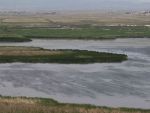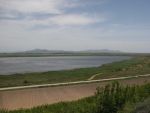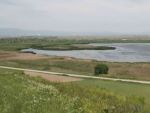|
GR010 Lake Mitrikou (Ismarida)
 |
 |
Criteria: A1, A4i, A4iii, B1i, B2, B3, C1, C2, C3, C4, C6
Coordinates:
40o 58' N
25o 17' E
()
|
Altitude: 0-54 m
Area: 6500 ha
|
|
 |
 |
Images
Site Description
A coastal wetland complex. It consists of the freshwater Lake Mitrikou, surrounded by extensive reedbeds ( Phragmites ), coastal lagoons and saltmarsh.
 |
 |
Habitats: Artificial landscapes (10%, Arable land), Wetland (90%, Coastal lagoons; Mud flats and sand flats; Rivers and streams; Salt marshes; Sand dunes and beaches; Standing brackish and salt water; Standing freshwater; Tidal rivers and enclosed tidal waters; Water fringe vegetation)
Land use: agriculture (10%), fisheries/aquaculture (85%), tourism/recreation (5%), water management (85%)
|
 |
 |
Protection status
National Partial International Partial
Part of IBA covered by Wildlife Refuge (Mavromatiou-Limni Mitrikou/Imerou-Mavromatiou, 1,900 ha). Part of IBA covered by Protected Area. Part of IBA covered by Ramsar Site (Lake Vistonis, Porto Lagos, Lake Ismaris and adjoining lagoons, 24,396 ha).
18000 ha of the IBA are covered by Special Protection Area (SPA) LIMNES VISTONIS, ISMARIS-LIMNOTHALASSES PORTO LAGOS, ALYKI PTELEA, XIROLIMNI, KARATZA(GR1130010).
Birds
The area is important for breeding, passage and wintering waterbirds, and breeding species associated with reedbeds. Species of global conservation concern that do not meet IBA criteria: Branta ruficollis (0- 3 wintering individuals), Oxyura leucocephala (wintering), Haliaeetus albicilla (wintering), Aquila heliaca (passage), Falco naumanni (passage), Larus audouinii . The site holds 20,000 waterbirds in winter, on a regular basis (including Tadorna tadorna 2,500; Anas penelope 6,000; Anas crecca 3,500; Anas platyrhynchos 10,000; Recurvirostra avosetta 2,500; Larus ridibundus 3,000).
| Species | Season | Year | Min | Max | Acc | Criteria |
|---|
| Cygnus olor Mute Swan | winter | 1996 | 500 | 1400 | unknown | B1i, C3
|
| Anser erythropus Lesser White-fronted Goose | winter | 1997 | 20 | - | unknown | A1, C1
|
| Tadorna ferruginea Ruddy Shelduck | resident | 0 | Uncommon | unknown | B2, C6
|
| Tadorna tadorna Common Shelduck | winter | 1996 | 800 | 2500 | unknown | B1i, C3
|
| Anas penelope Eurasian Wigeon | winter | 1996 | 1500 | 6000 | unknown | B1i, C3
|
| Aythya nyroca Ferruginous Duck | resident | 0 | Common | unknown | B2, C6
|
| Merops apiaster European Bee-eater | breeding | 0 | Abundant | unknown | B2
|
| Numenius tenuirostris Slender-billed Curlew | passage | 1997 | - | 1 | unknown | A1, C1
|
| Burhinus oedicnemus Eurasian Thick-knee | breeding | 0 | Common | unknown | C6
|
| Recurvirostra avosetta Pied Avocet | winter | 1996 | 700 | 2500 | unknown | A4i, B1i, B2, C6
|
| Vanellus spinosus Spur-winged Lapwing | breeding | 1993 | - | 4 | unknown | B2, C6
|
| Glareola pratincola Collared Pratincole | breeding | 0 | 20 | 100 | unknown | A4i, B1i, B2, C2
|
| Larus melanocephalus Mediterranean Gull | breeding | 0 | - | 600 | unknown | B3, C2, C6
|
| Larus minutus Little Gull | passage | 0 | - | 1200 | unknown | A4i, B1i, C3
|
| Chlidonias hybridus Whiskered Tern | breeding | 0 | 30 | 110 | unknown | B2, C6
|
| Podiceps nigricollis Black-necked Grebe | winter | 0 | - | 1000 | unknown | A4i, B1i, C3
|
| Phalacrocorax pygmeus Pygmy Cormorant | resident | 1996 | Frequent | unknown | B2, C6
|
| Phalacrocorax pygmeus Pygmy Cormorant | winter | 1997 | 110 | 350 | unknown | A1, A4i, B1i, C1, C2
|
| Phalacrocorax carbo Great Cormorant | winter | 1996 | 700 | 2500 | unknown | B1i, C3
|
| Casmerodius albus Great Egret | winter | 0 | - | 280 | unknown | A4i, B1i, C2
|
| Ardeola ralloides Squacco Heron | breeding | 0 | - | 80 | unknown | B2, C2, C6
|
| Ixobrychus minutus Little Bittern | breeding | 0 | 20 | 50 | unknown | C6
|
| Phoenicopterus ruber Greater Flamingo | passage | 1996 | 1500 | 5500 | unknown | A4i, B1i, C2
|
| Plegadis falcinellus Glossy Ibis | passage | 1996 | 50 | 2500 | unknown | A4i, B1i, C2
|
| Platalea leucorodia Eurasian Spoonbill | resident | 0 | - | 110 | unknown | A4i, B1i, B2, C2, C6
|
| Pelecanus crispus Dalmatian Pelican | passage | 1996 | Abundant | unknown | A1, C1
|
| Pelecanus crispus Dalmatian Pelican | winter | 1996 | 50 | 600 | unknown | A1, A4i, B1i, C1, C2
|
|
Conservation issues
Chemical and sewerage pollution, water abstraction, hunting, the expansion of agricultural land and infrastructure developments are the main threats. The area is a candidate SAC.
 |
 |
Threats:
agricultural intensification/expansion (high), aquaculture/fisheries (medium), drainage (unknown), groundwater abstraction (medium), industrialization/urbanization (high), infrastructure (high), recreation/tourism (medium), unsustainable exploitation (high)
|
 |
 |
Source:
Copyright © Hellenic Ornithological Society
|
|

Do you know the area?
Send us your comments at iba@ornithologiki.gr
If you have noticed serious damage to the area and you want to report it please click here
 
|







